Investigating Environmental Risks in Maritime Logistics: Australia
VerifiedAdded on 2023/05/30
|28
|5464
|355
Report
AI Summary
This report presents a research methodology for investigating environmental risks in the maritime logistics sector, with a specific focus on Australian cases. The study adopts a positivism philosophy and a deductive approach, utilizing a descriptive design to evaluate relevant concepts. Data collection involves both primary and secondary sources, with primary data gathered through a survey using a questionnaire and secondary data sourced from the internet. The research aims to analyze environmental hazards, assess the vulnerability of the industry, and recommend strategies for mitigating environmental risks. The methodology encompasses research design, target population, sampling techniques, data collection instruments, and ethical considerations. The report outlines the research hypotheses, data analysis methods, and anticipated limitations, offering insights into the environmental challenges and potential solutions within the Australian maritime logistics context.
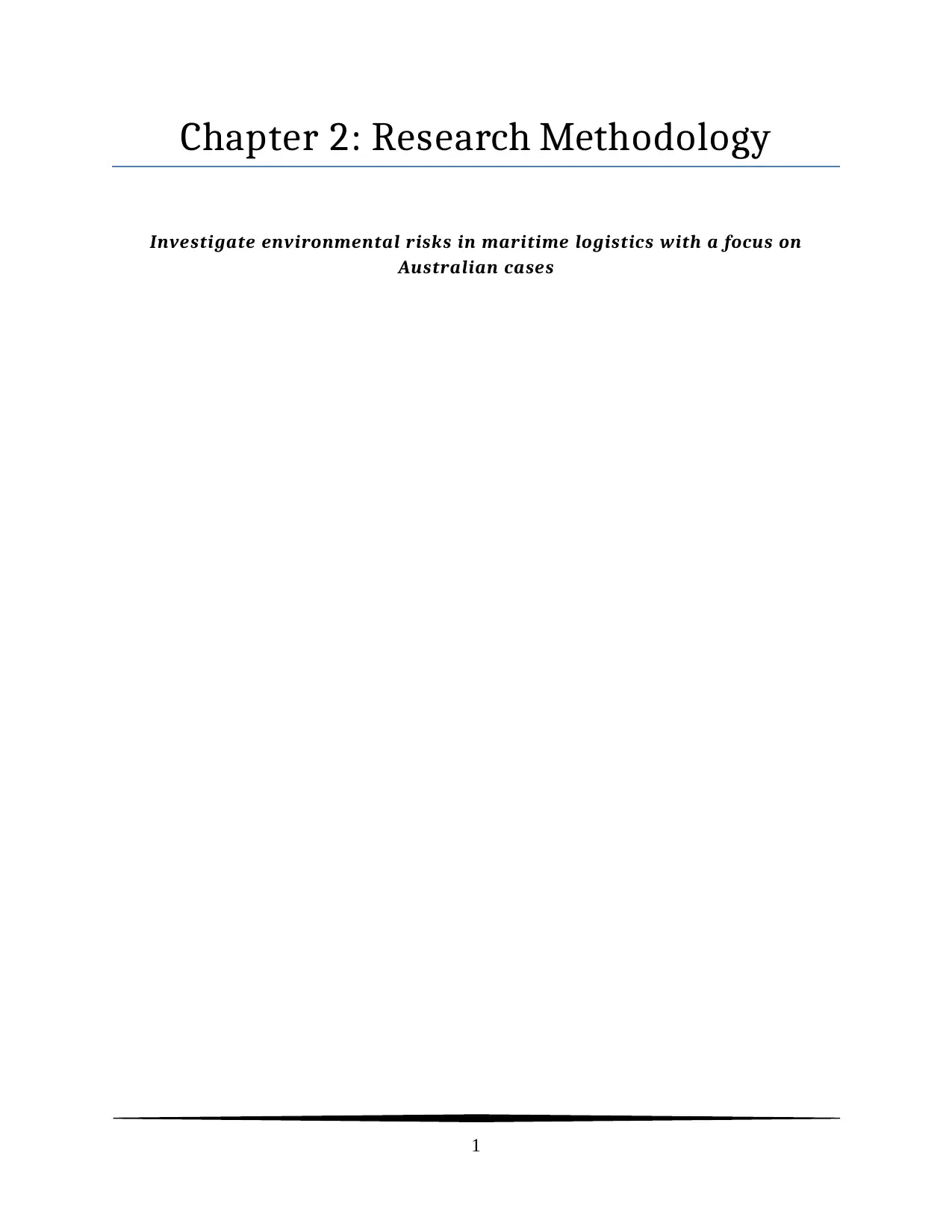
Chapter 2: Research Methodology
Investigate environmental risks in maritime logistics with a focus on
Australian cases
1
Investigate environmental risks in maritime logistics with a focus on
Australian cases
1
Paraphrase This Document
Need a fresh take? Get an instant paraphrase of this document with our AI Paraphraser
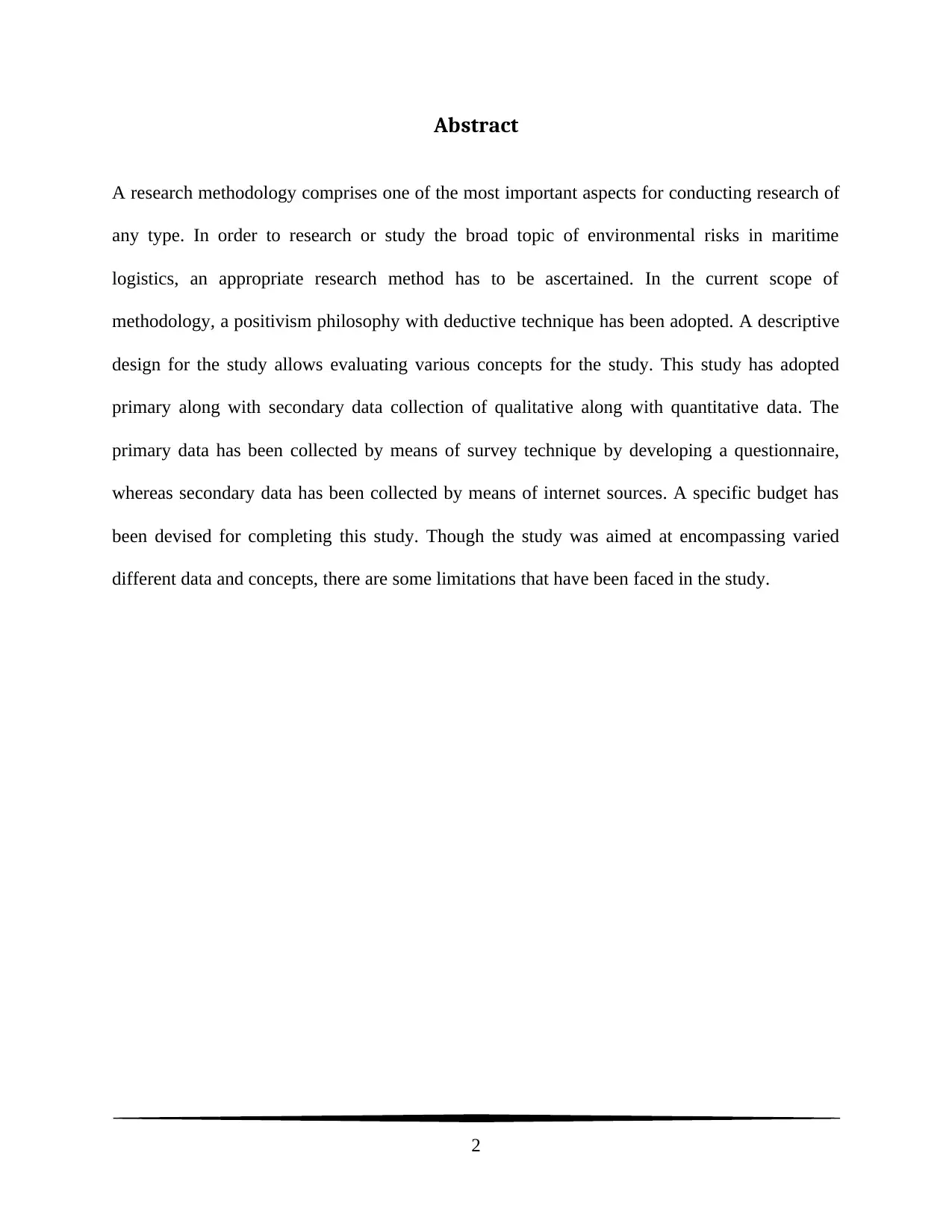
Abstract
A research methodology comprises one of the most important aspects for conducting research of
any type. In order to research or study the broad topic of environmental risks in maritime
logistics, an appropriate research method has to be ascertained. In the current scope of
methodology, a positivism philosophy with deductive technique has been adopted. A descriptive
design for the study allows evaluating various concepts for the study. This study has adopted
primary along with secondary data collection of qualitative along with quantitative data. The
primary data has been collected by means of survey technique by developing a questionnaire,
whereas secondary data has been collected by means of internet sources. A specific budget has
been devised for completing this study. Though the study was aimed at encompassing varied
different data and concepts, there are some limitations that have been faced in the study.
2
A research methodology comprises one of the most important aspects for conducting research of
any type. In order to research or study the broad topic of environmental risks in maritime
logistics, an appropriate research method has to be ascertained. In the current scope of
methodology, a positivism philosophy with deductive technique has been adopted. A descriptive
design for the study allows evaluating various concepts for the study. This study has adopted
primary along with secondary data collection of qualitative along with quantitative data. The
primary data has been collected by means of survey technique by developing a questionnaire,
whereas secondary data has been collected by means of internet sources. A specific budget has
been devised for completing this study. Though the study was aimed at encompassing varied
different data and concepts, there are some limitations that have been faced in the study.
2
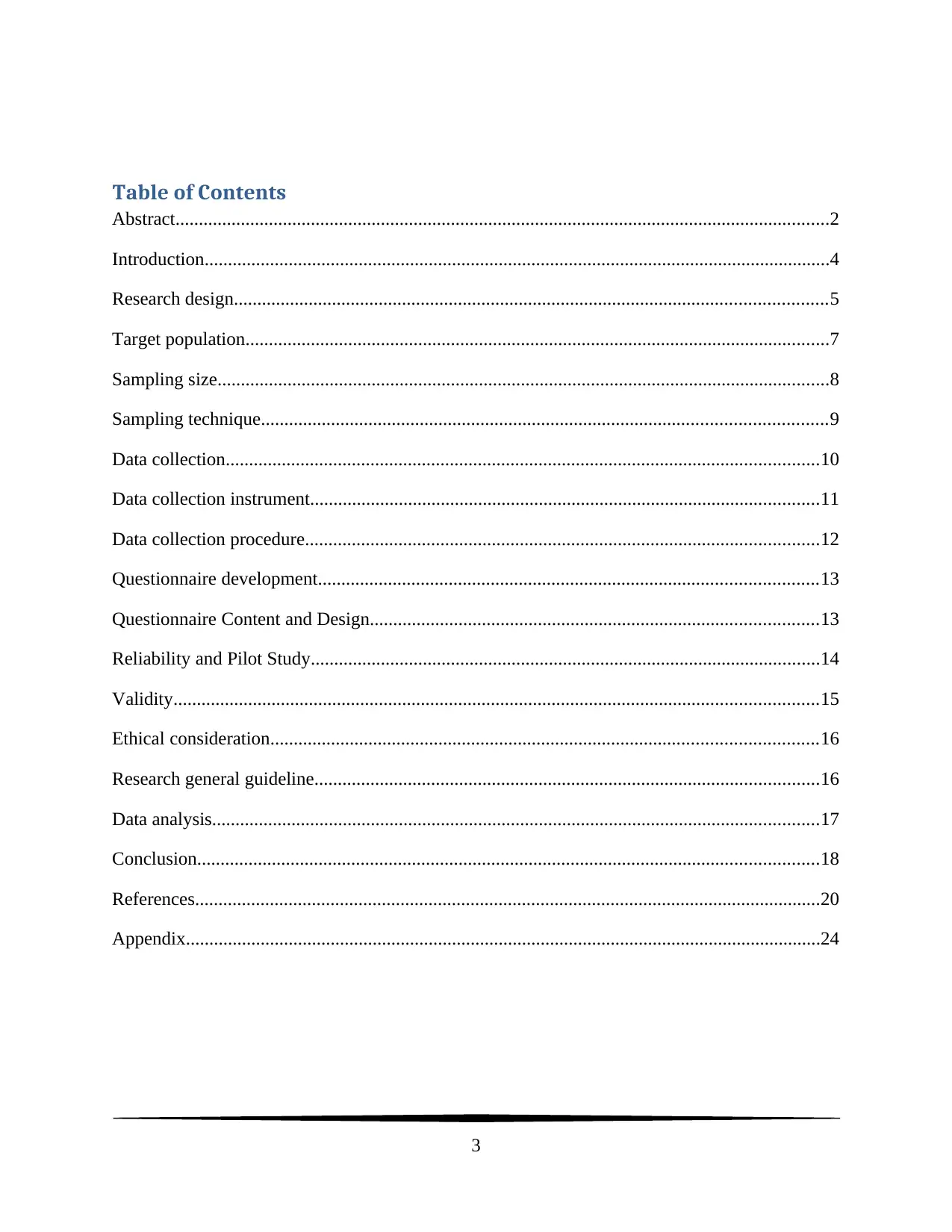
Table of Contents
Abstract............................................................................................................................................2
Introduction......................................................................................................................................4
Research design...............................................................................................................................5
Target population.............................................................................................................................7
Sampling size...................................................................................................................................8
Sampling technique.........................................................................................................................9
Data collection...............................................................................................................................10
Data collection instrument.............................................................................................................11
Data collection procedure..............................................................................................................12
Questionnaire development...........................................................................................................13
Questionnaire Content and Design................................................................................................13
Reliability and Pilot Study.............................................................................................................14
Validity..........................................................................................................................................15
Ethical consideration.....................................................................................................................16
Research general guideline............................................................................................................16
Data analysis..................................................................................................................................17
Conclusion.....................................................................................................................................18
References......................................................................................................................................20
Appendix........................................................................................................................................24
3
Abstract............................................................................................................................................2
Introduction......................................................................................................................................4
Research design...............................................................................................................................5
Target population.............................................................................................................................7
Sampling size...................................................................................................................................8
Sampling technique.........................................................................................................................9
Data collection...............................................................................................................................10
Data collection instrument.............................................................................................................11
Data collection procedure..............................................................................................................12
Questionnaire development...........................................................................................................13
Questionnaire Content and Design................................................................................................13
Reliability and Pilot Study.............................................................................................................14
Validity..........................................................................................................................................15
Ethical consideration.....................................................................................................................16
Research general guideline............................................................................................................16
Data analysis..................................................................................................................................17
Conclusion.....................................................................................................................................18
References......................................................................................................................................20
Appendix........................................................................................................................................24
3
⊘ This is a preview!⊘
Do you want full access?
Subscribe today to unlock all pages.

Trusted by 1+ million students worldwide
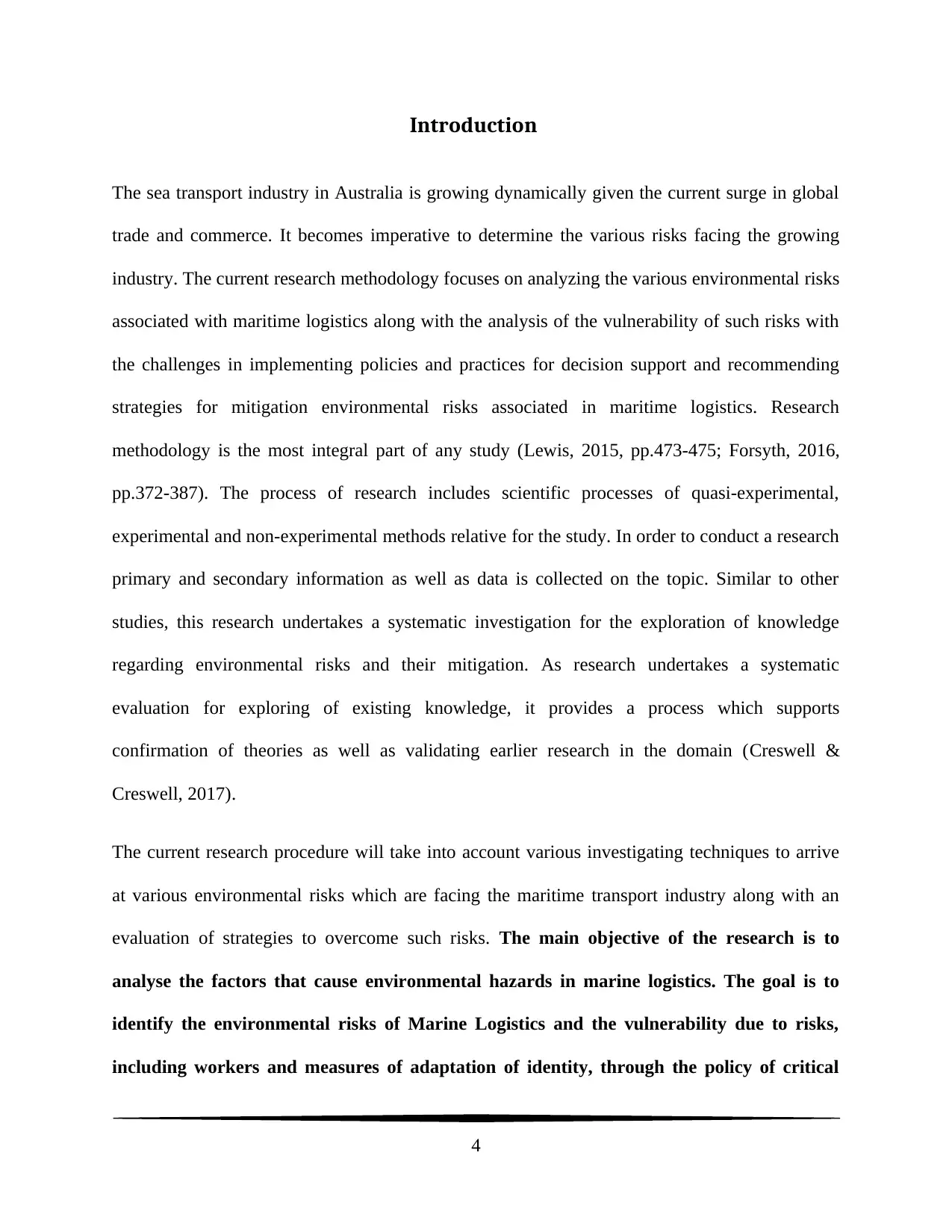
Introduction
The sea transport industry in Australia is growing dynamically given the current surge in global
trade and commerce. It becomes imperative to determine the various risks facing the growing
industry. The current research methodology focuses on analyzing the various environmental risks
associated with maritime logistics along with the analysis of the vulnerability of such risks with
the challenges in implementing policies and practices for decision support and recommending
strategies for mitigation environmental risks associated in maritime logistics. Research
methodology is the most integral part of any study (Lewis, 2015, pp.473-475; Forsyth, 2016,
pp.372-387). The process of research includes scientific processes of quasi-experimental,
experimental and non-experimental methods relative for the study. In order to conduct a research
primary and secondary information as well as data is collected on the topic. Similar to other
studies, this research undertakes a systematic investigation for the exploration of knowledge
regarding environmental risks and their mitigation. As research undertakes a systematic
evaluation for exploring of existing knowledge, it provides a process which supports
confirmation of theories as well as validating earlier research in the domain (Creswell &
Creswell, 2017).
The current research procedure will take into account various investigating techniques to arrive
at various environmental risks which are facing the maritime transport industry along with an
evaluation of strategies to overcome such risks. The main objective of the research is to
analyse the factors that cause environmental hazards in marine logistics. The goal is to
identify the environmental risks of Marine Logistics and the vulnerability due to risks,
including workers and measures of adaptation of identity, through the policy of critical
4
The sea transport industry in Australia is growing dynamically given the current surge in global
trade and commerce. It becomes imperative to determine the various risks facing the growing
industry. The current research methodology focuses on analyzing the various environmental risks
associated with maritime logistics along with the analysis of the vulnerability of such risks with
the challenges in implementing policies and practices for decision support and recommending
strategies for mitigation environmental risks associated in maritime logistics. Research
methodology is the most integral part of any study (Lewis, 2015, pp.473-475; Forsyth, 2016,
pp.372-387). The process of research includes scientific processes of quasi-experimental,
experimental and non-experimental methods relative for the study. In order to conduct a research
primary and secondary information as well as data is collected on the topic. Similar to other
studies, this research undertakes a systematic investigation for the exploration of knowledge
regarding environmental risks and their mitigation. As research undertakes a systematic
evaluation for exploring of existing knowledge, it provides a process which supports
confirmation of theories as well as validating earlier research in the domain (Creswell &
Creswell, 2017).
The current research procedure will take into account various investigating techniques to arrive
at various environmental risks which are facing the maritime transport industry along with an
evaluation of strategies to overcome such risks. The main objective of the research is to
analyse the factors that cause environmental hazards in marine logistics. The goal is to
identify the environmental risks of Marine Logistics and the vulnerability due to risks,
including workers and measures of adaptation of identity, through the policy of critical
4
Paraphrase This Document
Need a fresh take? Get an instant paraphrase of this document with our AI Paraphraser
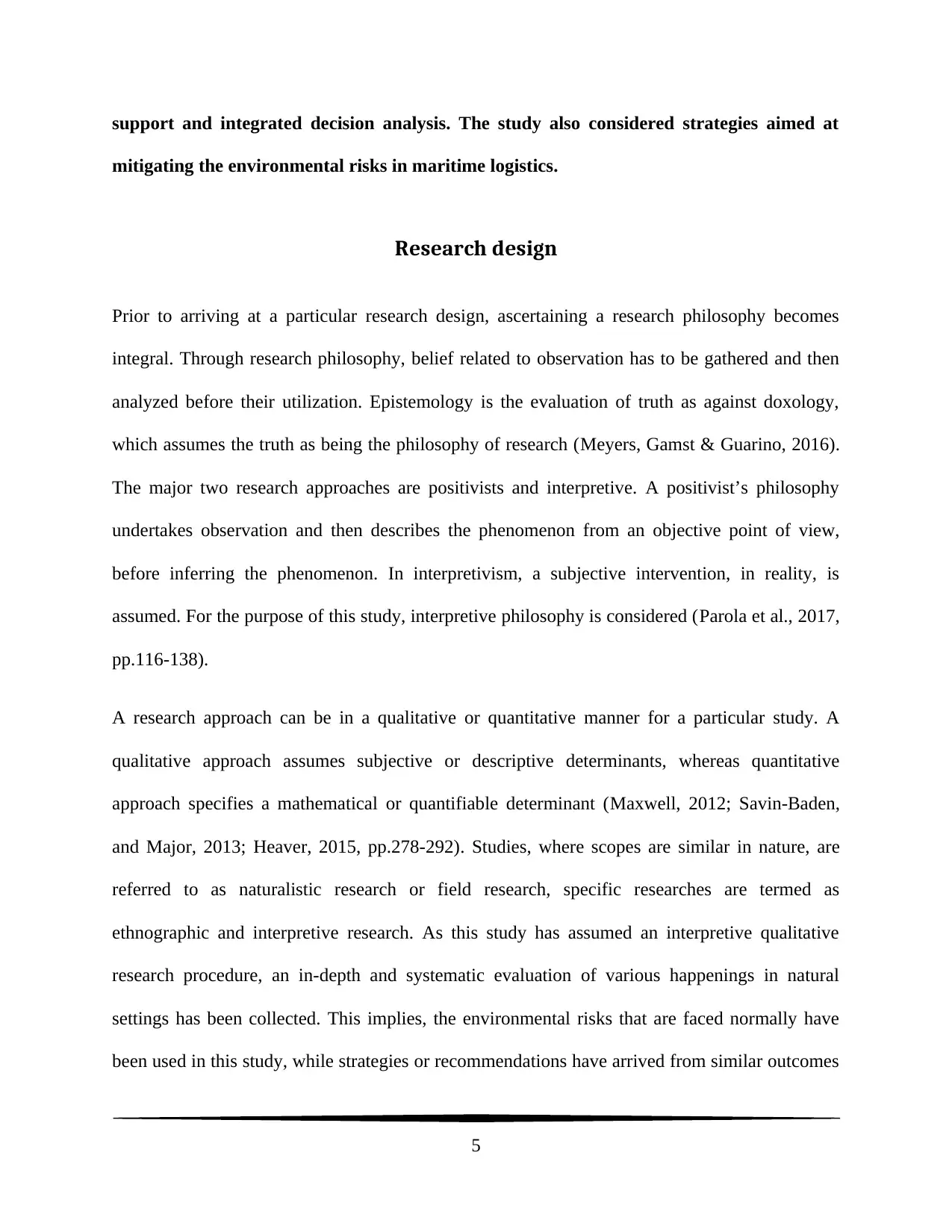
support and integrated decision analysis. The study also considered strategies aimed at
mitigating the environmental risks in maritime logistics.
Research design
Prior to arriving at a particular research design, ascertaining a research philosophy becomes
integral. Through research philosophy, belief related to observation has to be gathered and then
analyzed before their utilization. Epistemology is the evaluation of truth as against doxology,
which assumes the truth as being the philosophy of research (Meyers, Gamst & Guarino, 2016).
The major two research approaches are positivists and interpretive. A positivist’s philosophy
undertakes observation and then describes the phenomenon from an objective point of view,
before inferring the phenomenon. In interpretivism, a subjective intervention, in reality, is
assumed. For the purpose of this study, interpretive philosophy is considered (Parola et al., 2017,
pp.116-138).
A research approach can be in a qualitative or quantitative manner for a particular study. A
qualitative approach assumes subjective or descriptive determinants, whereas quantitative
approach specifies a mathematical or quantifiable determinant (Maxwell, 2012; Savin-Baden,
and Major, 2013; Heaver, 2015, pp.278-292). Studies, where scopes are similar in nature, are
referred to as naturalistic research or field research, specific researches are termed as
ethnographic and interpretive research. As this study has assumed an interpretive qualitative
research procedure, an in-depth and systematic evaluation of various happenings in natural
settings has been collected. This implies, the environmental risks that are faced normally have
been used in this study, while strategies or recommendations have arrived from similar outcomes
5
mitigating the environmental risks in maritime logistics.
Research design
Prior to arriving at a particular research design, ascertaining a research philosophy becomes
integral. Through research philosophy, belief related to observation has to be gathered and then
analyzed before their utilization. Epistemology is the evaluation of truth as against doxology,
which assumes the truth as being the philosophy of research (Meyers, Gamst & Guarino, 2016).
The major two research approaches are positivists and interpretive. A positivist’s philosophy
undertakes observation and then describes the phenomenon from an objective point of view,
before inferring the phenomenon. In interpretivism, a subjective intervention, in reality, is
assumed. For the purpose of this study, interpretive philosophy is considered (Parola et al., 2017,
pp.116-138).
A research approach can be in a qualitative or quantitative manner for a particular study. A
qualitative approach assumes subjective or descriptive determinants, whereas quantitative
approach specifies a mathematical or quantifiable determinant (Maxwell, 2012; Savin-Baden,
and Major, 2013; Heaver, 2015, pp.278-292). Studies, where scopes are similar in nature, are
referred to as naturalistic research or field research, specific researches are termed as
ethnographic and interpretive research. As this study has assumed an interpretive qualitative
research procedure, an in-depth and systematic evaluation of various happenings in natural
settings has been collected. This implies, the environmental risks that are faced normally have
been used in this study, while strategies or recommendations have arrived from similar outcomes
5
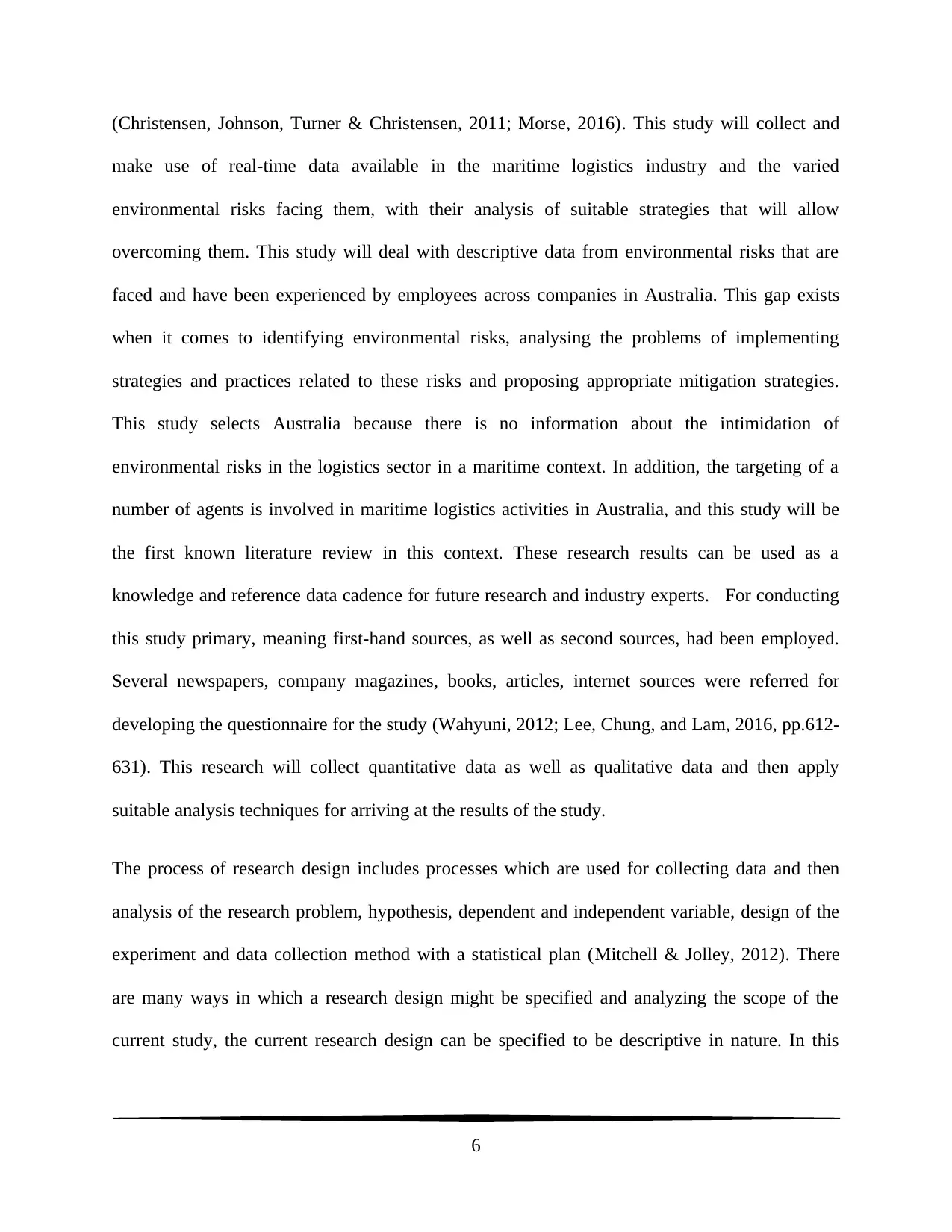
(Christensen, Johnson, Turner & Christensen, 2011; Morse, 2016). This study will collect and
make use of real-time data available in the maritime logistics industry and the varied
environmental risks facing them, with their analysis of suitable strategies that will allow
overcoming them. This study will deal with descriptive data from environmental risks that are
faced and have been experienced by employees across companies in Australia. This gap exists
when it comes to identifying environmental risks, analysing the problems of implementing
strategies and practices related to these risks and proposing appropriate mitigation strategies.
This study selects Australia because there is no information about the intimidation of
environmental risks in the logistics sector in a maritime context. In addition, the targeting of a
number of agents is involved in maritime logistics activities in Australia, and this study will be
the first known literature review in this context. These research results can be used as a
knowledge and reference data cadence for future research and industry experts. For conducting
this study primary, meaning first-hand sources, as well as second sources, had been employed.
Several newspapers, company magazines, books, articles, internet sources were referred for
developing the questionnaire for the study (Wahyuni, 2012; Lee, Chung, and Lam, 2016, pp.612-
631). This research will collect quantitative data as well as qualitative data and then apply
suitable analysis techniques for arriving at the results of the study.
The process of research design includes processes which are used for collecting data and then
analysis of the research problem, hypothesis, dependent and independent variable, design of the
experiment and data collection method with a statistical plan (Mitchell & Jolley, 2012). There
are many ways in which a research design might be specified and analyzing the scope of the
current study, the current research design can be specified to be descriptive in nature. In this
6
make use of real-time data available in the maritime logistics industry and the varied
environmental risks facing them, with their analysis of suitable strategies that will allow
overcoming them. This study will deal with descriptive data from environmental risks that are
faced and have been experienced by employees across companies in Australia. This gap exists
when it comes to identifying environmental risks, analysing the problems of implementing
strategies and practices related to these risks and proposing appropriate mitigation strategies.
This study selects Australia because there is no information about the intimidation of
environmental risks in the logistics sector in a maritime context. In addition, the targeting of a
number of agents is involved in maritime logistics activities in Australia, and this study will be
the first known literature review in this context. These research results can be used as a
knowledge and reference data cadence for future research and industry experts. For conducting
this study primary, meaning first-hand sources, as well as second sources, had been employed.
Several newspapers, company magazines, books, articles, internet sources were referred for
developing the questionnaire for the study (Wahyuni, 2012; Lee, Chung, and Lam, 2016, pp.612-
631). This research will collect quantitative data as well as qualitative data and then apply
suitable analysis techniques for arriving at the results of the study.
The process of research design includes processes which are used for collecting data and then
analysis of the research problem, hypothesis, dependent and independent variable, design of the
experiment and data collection method with a statistical plan (Mitchell & Jolley, 2012). There
are many ways in which a research design might be specified and analyzing the scope of the
current study, the current research design can be specified to be descriptive in nature. In this
6
⊘ This is a preview!⊘
Do you want full access?
Subscribe today to unlock all pages.

Trusted by 1+ million students worldwide
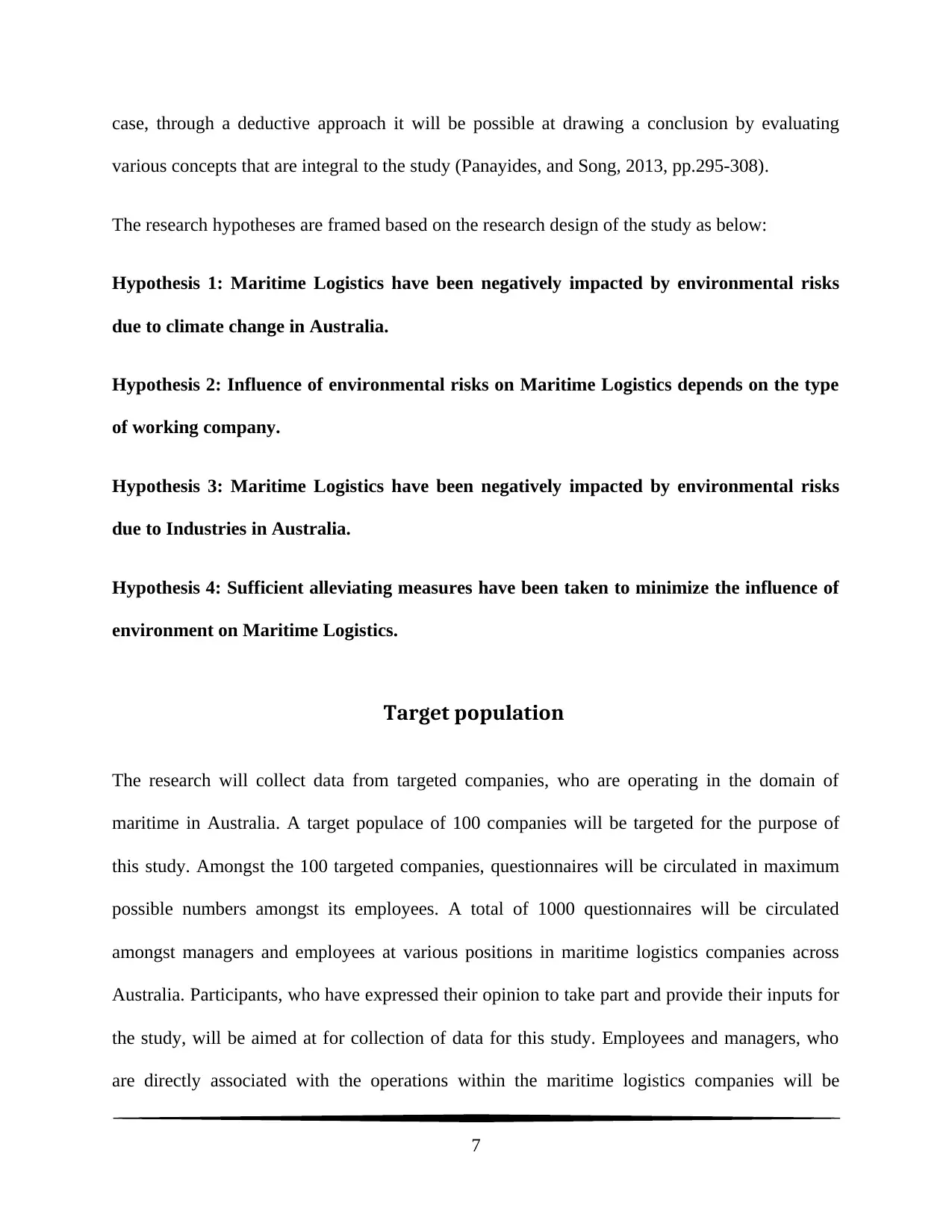
case, through a deductive approach it will be possible at drawing a conclusion by evaluating
various concepts that are integral to the study (Panayides, and Song, 2013, pp.295-308).
The research hypotheses are framed based on the research design of the study as below:
Hypothesis 1: Maritime Logistics have been negatively impacted by environmental risks
due to climate change in Australia.
Hypothesis 2: Influence of environmental risks on Maritime Logistics depends on the type
of working company.
Hypothesis 3: Maritime Logistics have been negatively impacted by environmental risks
due to Industries in Australia.
Hypothesis 4: Sufficient alleviating measures have been taken to minimize the influence of
environment on Maritime Logistics.
Target population
The research will collect data from targeted companies, who are operating in the domain of
maritime in Australia. A target populace of 100 companies will be targeted for the purpose of
this study. Amongst the 100 targeted companies, questionnaires will be circulated in maximum
possible numbers amongst its employees. A total of 1000 questionnaires will be circulated
amongst managers and employees at various positions in maritime logistics companies across
Australia. Participants, who have expressed their opinion to take part and provide their inputs for
the study, will be aimed at for collection of data for this study. Employees and managers, who
are directly associated with the operations within the maritime logistics companies will be
7
various concepts that are integral to the study (Panayides, and Song, 2013, pp.295-308).
The research hypotheses are framed based on the research design of the study as below:
Hypothesis 1: Maritime Logistics have been negatively impacted by environmental risks
due to climate change in Australia.
Hypothesis 2: Influence of environmental risks on Maritime Logistics depends on the type
of working company.
Hypothesis 3: Maritime Logistics have been negatively impacted by environmental risks
due to Industries in Australia.
Hypothesis 4: Sufficient alleviating measures have been taken to minimize the influence of
environment on Maritime Logistics.
Target population
The research will collect data from targeted companies, who are operating in the domain of
maritime in Australia. A target populace of 100 companies will be targeted for the purpose of
this study. Amongst the 100 targeted companies, questionnaires will be circulated in maximum
possible numbers amongst its employees. A total of 1000 questionnaires will be circulated
amongst managers and employees at various positions in maritime logistics companies across
Australia. Participants, who have expressed their opinion to take part and provide their inputs for
the study, will be aimed at for collection of data for this study. Employees and managers, who
are directly associated with the operations within the maritime logistics companies will be
7
Paraphrase This Document
Need a fresh take? Get an instant paraphrase of this document with our AI Paraphraser
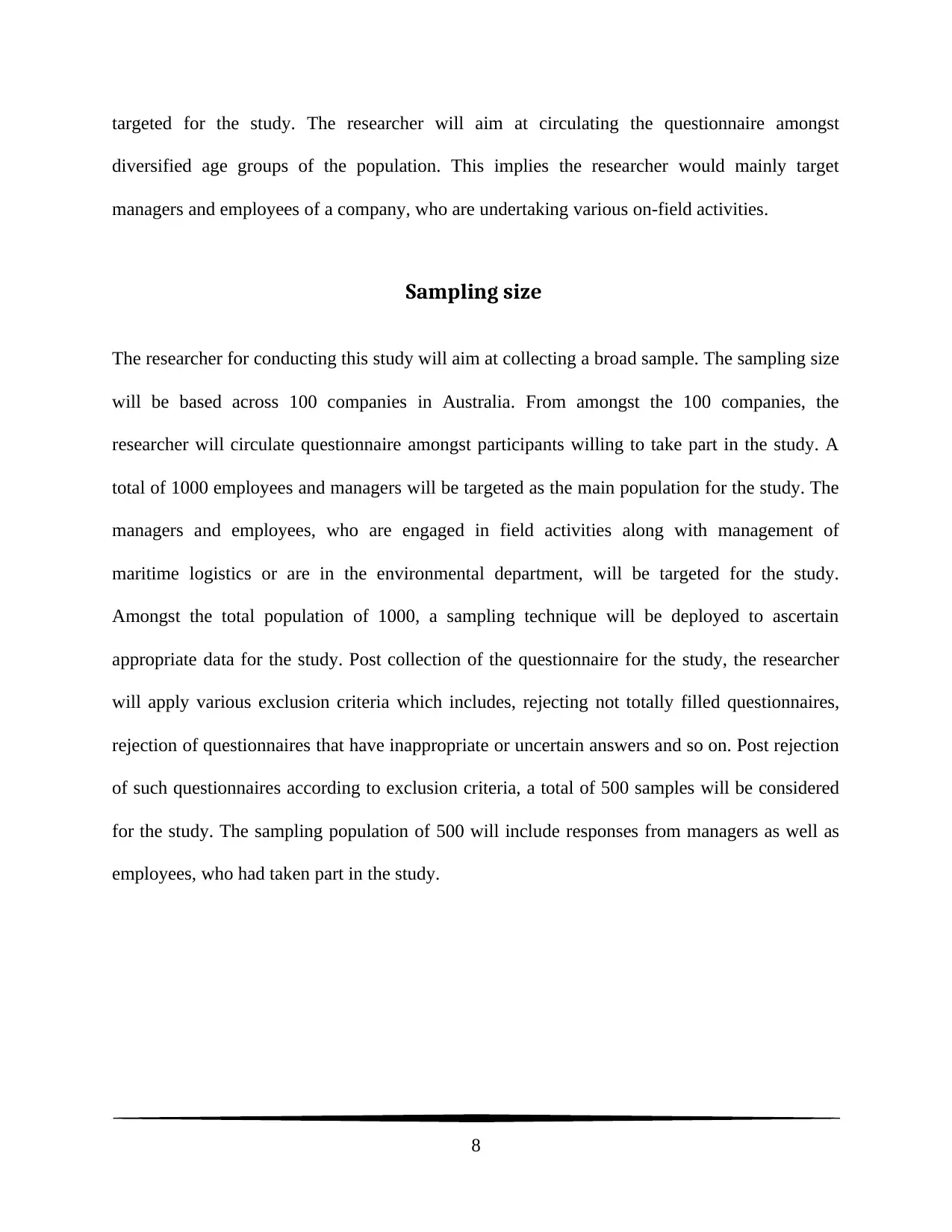
targeted for the study. The researcher will aim at circulating the questionnaire amongst
diversified age groups of the population. This implies the researcher would mainly target
managers and employees of a company, who are undertaking various on-field activities.
Sampling size
The researcher for conducting this study will aim at collecting a broad sample. The sampling size
will be based across 100 companies in Australia. From amongst the 100 companies, the
researcher will circulate questionnaire amongst participants willing to take part in the study. A
total of 1000 employees and managers will be targeted as the main population for the study. The
managers and employees, who are engaged in field activities along with management of
maritime logistics or are in the environmental department, will be targeted for the study.
Amongst the total population of 1000, a sampling technique will be deployed to ascertain
appropriate data for the study. Post collection of the questionnaire for the study, the researcher
will apply various exclusion criteria which includes, rejecting not totally filled questionnaires,
rejection of questionnaires that have inappropriate or uncertain answers and so on. Post rejection
of such questionnaires according to exclusion criteria, a total of 500 samples will be considered
for the study. The sampling population of 500 will include responses from managers as well as
employees, who had taken part in the study.
8
diversified age groups of the population. This implies the researcher would mainly target
managers and employees of a company, who are undertaking various on-field activities.
Sampling size
The researcher for conducting this study will aim at collecting a broad sample. The sampling size
will be based across 100 companies in Australia. From amongst the 100 companies, the
researcher will circulate questionnaire amongst participants willing to take part in the study. A
total of 1000 employees and managers will be targeted as the main population for the study. The
managers and employees, who are engaged in field activities along with management of
maritime logistics or are in the environmental department, will be targeted for the study.
Amongst the total population of 1000, a sampling technique will be deployed to ascertain
appropriate data for the study. Post collection of the questionnaire for the study, the researcher
will apply various exclusion criteria which includes, rejecting not totally filled questionnaires,
rejection of questionnaires that have inappropriate or uncertain answers and so on. Post rejection
of such questionnaires according to exclusion criteria, a total of 500 samples will be considered
for the study. The sampling population of 500 will include responses from managers as well as
employees, who had taken part in the study.
8
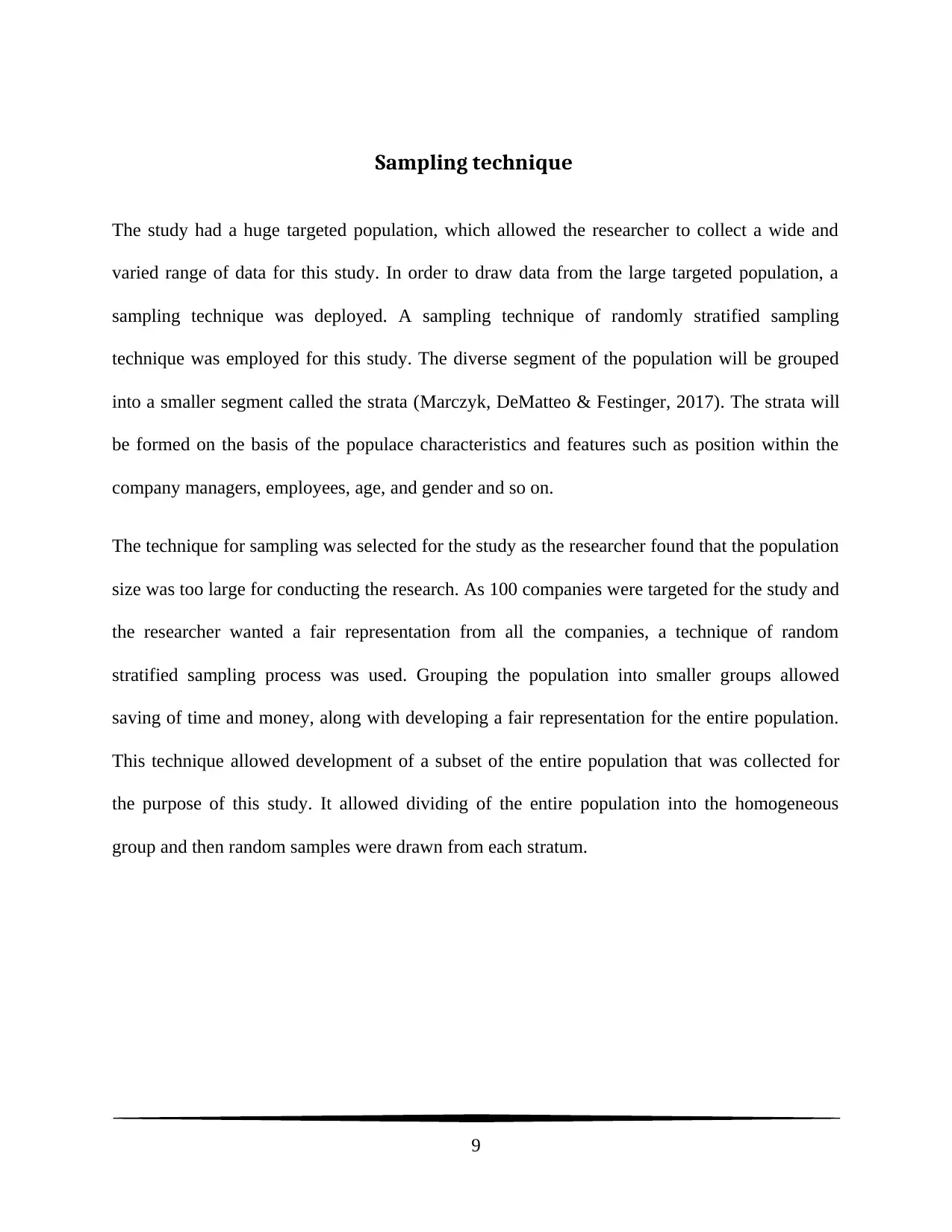
Sampling technique
The study had a huge targeted population, which allowed the researcher to collect a wide and
varied range of data for this study. In order to draw data from the large targeted population, a
sampling technique was deployed. A sampling technique of randomly stratified sampling
technique was employed for this study. The diverse segment of the population will be grouped
into a smaller segment called the strata (Marczyk, DeMatteo & Festinger, 2017). The strata will
be formed on the basis of the populace characteristics and features such as position within the
company managers, employees, age, and gender and so on.
The technique for sampling was selected for the study as the researcher found that the population
size was too large for conducting the research. As 100 companies were targeted for the study and
the researcher wanted a fair representation from all the companies, a technique of random
stratified sampling process was used. Grouping the population into smaller groups allowed
saving of time and money, along with developing a fair representation for the entire population.
This technique allowed development of a subset of the entire population that was collected for
the purpose of this study. It allowed dividing of the entire population into the homogeneous
group and then random samples were drawn from each stratum.
9
The study had a huge targeted population, which allowed the researcher to collect a wide and
varied range of data for this study. In order to draw data from the large targeted population, a
sampling technique was deployed. A sampling technique of randomly stratified sampling
technique was employed for this study. The diverse segment of the population will be grouped
into a smaller segment called the strata (Marczyk, DeMatteo & Festinger, 2017). The strata will
be formed on the basis of the populace characteristics and features such as position within the
company managers, employees, age, and gender and so on.
The technique for sampling was selected for the study as the researcher found that the population
size was too large for conducting the research. As 100 companies were targeted for the study and
the researcher wanted a fair representation from all the companies, a technique of random
stratified sampling process was used. Grouping the population into smaller groups allowed
saving of time and money, along with developing a fair representation for the entire population.
This technique allowed development of a subset of the entire population that was collected for
the purpose of this study. It allowed dividing of the entire population into the homogeneous
group and then random samples were drawn from each stratum.
9
⊘ This is a preview!⊘
Do you want full access?
Subscribe today to unlock all pages.

Trusted by 1+ million students worldwide
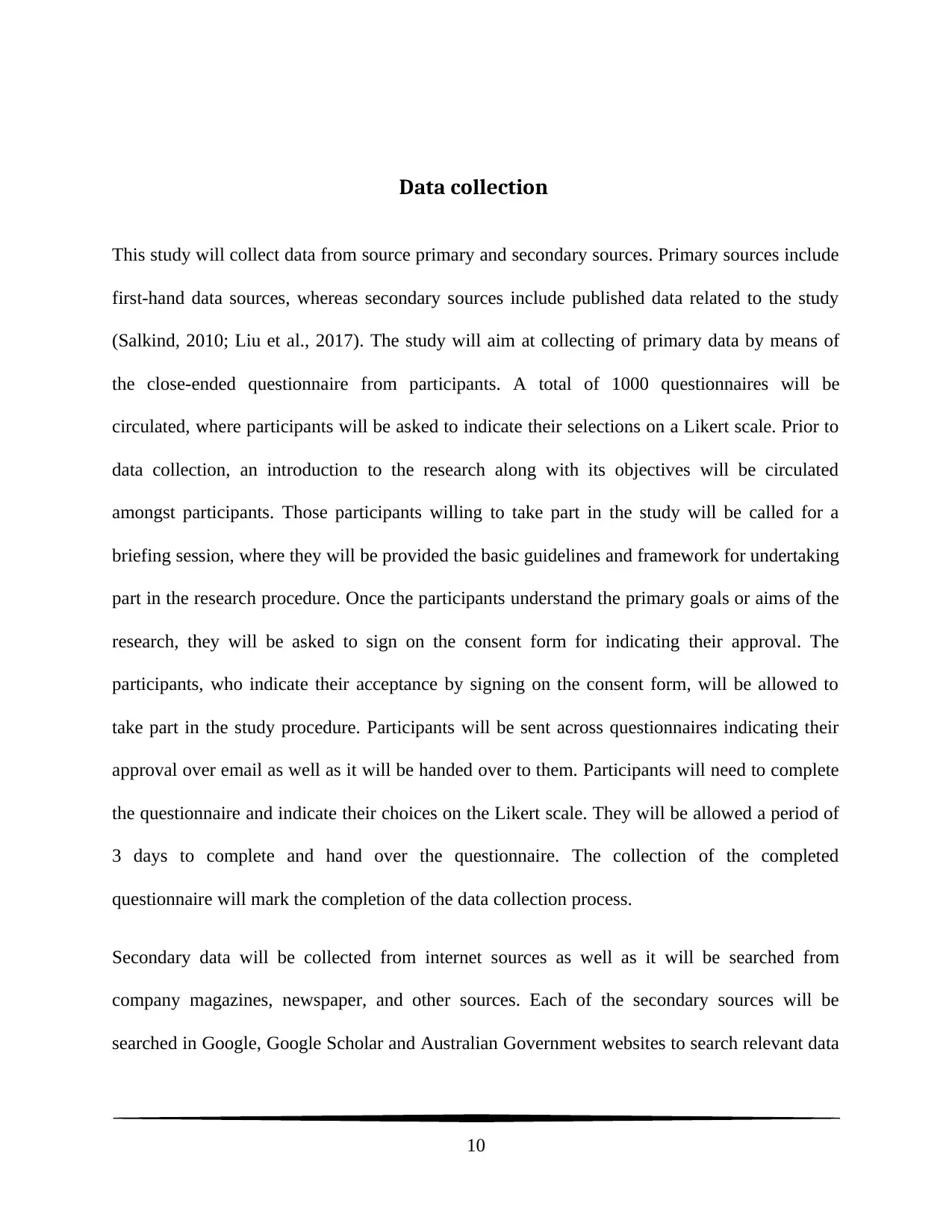
Data collection
This study will collect data from source primary and secondary sources. Primary sources include
first-hand data sources, whereas secondary sources include published data related to the study
(Salkind, 2010; Liu et al., 2017). The study will aim at collecting of primary data by means of
the close-ended questionnaire from participants. A total of 1000 questionnaires will be
circulated, where participants will be asked to indicate their selections on a Likert scale. Prior to
data collection, an introduction to the research along with its objectives will be circulated
amongst participants. Those participants willing to take part in the study will be called for a
briefing session, where they will be provided the basic guidelines and framework for undertaking
part in the research procedure. Once the participants understand the primary goals or aims of the
research, they will be asked to sign on the consent form for indicating their approval. The
participants, who indicate their acceptance by signing on the consent form, will be allowed to
take part in the study procedure. Participants will be sent across questionnaires indicating their
approval over email as well as it will be handed over to them. Participants will need to complete
the questionnaire and indicate their choices on the Likert scale. They will be allowed a period of
3 days to complete and hand over the questionnaire. The collection of the completed
questionnaire will mark the completion of the data collection process.
Secondary data will be collected from internet sources as well as it will be searched from
company magazines, newspaper, and other sources. Each of the secondary sources will be
searched in Google, Google Scholar and Australian Government websites to search relevant data
10
This study will collect data from source primary and secondary sources. Primary sources include
first-hand data sources, whereas secondary sources include published data related to the study
(Salkind, 2010; Liu et al., 2017). The study will aim at collecting of primary data by means of
the close-ended questionnaire from participants. A total of 1000 questionnaires will be
circulated, where participants will be asked to indicate their selections on a Likert scale. Prior to
data collection, an introduction to the research along with its objectives will be circulated
amongst participants. Those participants willing to take part in the study will be called for a
briefing session, where they will be provided the basic guidelines and framework for undertaking
part in the research procedure. Once the participants understand the primary goals or aims of the
research, they will be asked to sign on the consent form for indicating their approval. The
participants, who indicate their acceptance by signing on the consent form, will be allowed to
take part in the study procedure. Participants will be sent across questionnaires indicating their
approval over email as well as it will be handed over to them. Participants will need to complete
the questionnaire and indicate their choices on the Likert scale. They will be allowed a period of
3 days to complete and hand over the questionnaire. The collection of the completed
questionnaire will mark the completion of the data collection process.
Secondary data will be collected from internet sources as well as it will be searched from
company magazines, newspaper, and other sources. Each of the secondary sources will be
searched in Google, Google Scholar and Australian Government websites to search relevant data
10
Paraphrase This Document
Need a fresh take? Get an instant paraphrase of this document with our AI Paraphraser
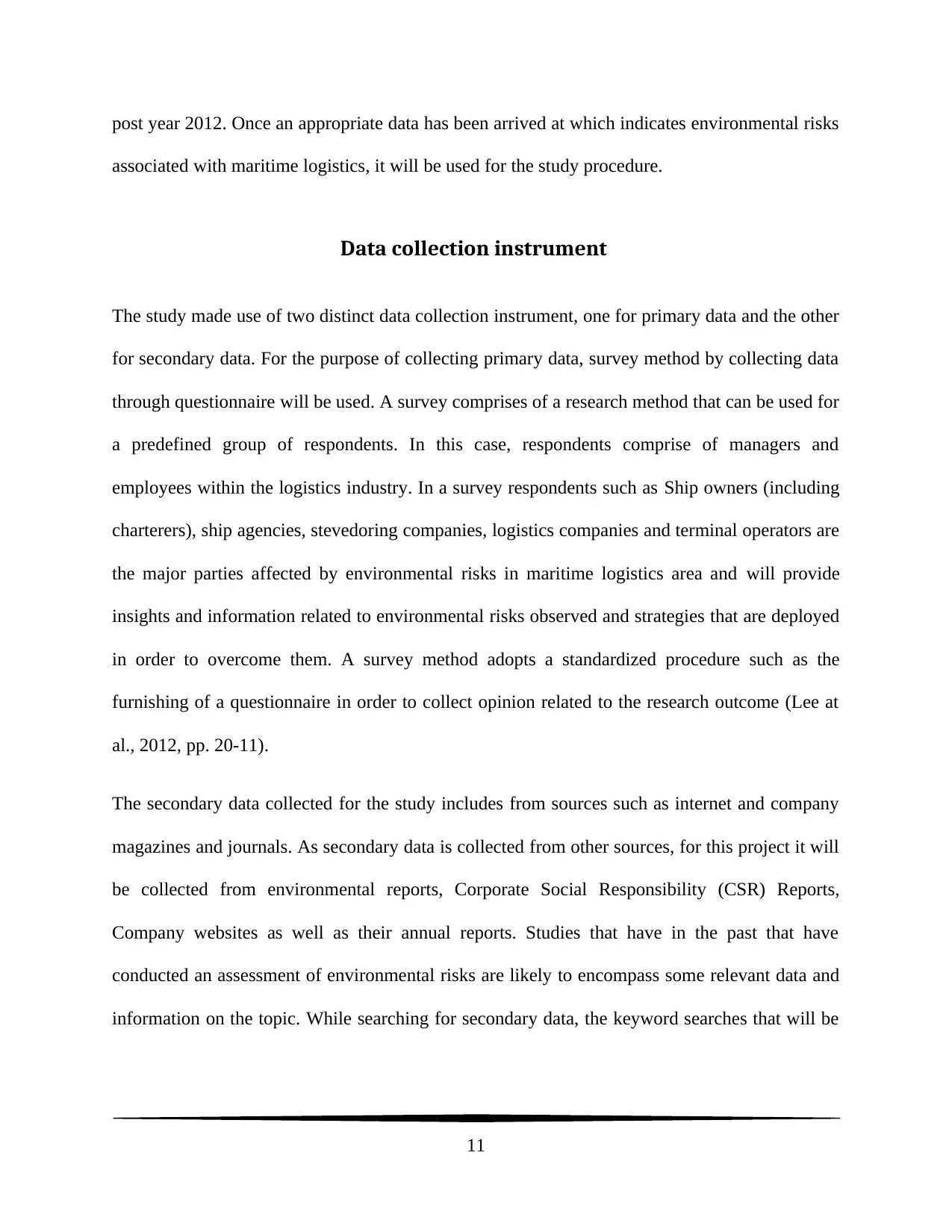
post year 2012. Once an appropriate data has been arrived at which indicates environmental risks
associated with maritime logistics, it will be used for the study procedure.
Data collection instrument
The study made use of two distinct data collection instrument, one for primary data and the other
for secondary data. For the purpose of collecting primary data, survey method by collecting data
through questionnaire will be used. A survey comprises of a research method that can be used for
a predefined group of respondents. In this case, respondents comprise of managers and
employees within the logistics industry. In a survey respondents such as Ship owners (including
charterers), ship agencies, stevedoring companies, logistics companies and terminal operators are
the major parties affected by environmental risks in maritime logistics area and will provide
insights and information related to environmental risks observed and strategies that are deployed
in order to overcome them. A survey method adopts a standardized procedure such as the
furnishing of a questionnaire in order to collect opinion related to the research outcome (Lee at
al., 2012, pp. 20-11).
The secondary data collected for the study includes from sources such as internet and company
magazines and journals. As secondary data is collected from other sources, for this project it will
be collected from environmental reports, Corporate Social Responsibility (CSR) Reports,
Company websites as well as their annual reports. Studies that have in the past that have
conducted an assessment of environmental risks are likely to encompass some relevant data and
information on the topic. While searching for secondary data, the keyword searches that will be
11
associated with maritime logistics, it will be used for the study procedure.
Data collection instrument
The study made use of two distinct data collection instrument, one for primary data and the other
for secondary data. For the purpose of collecting primary data, survey method by collecting data
through questionnaire will be used. A survey comprises of a research method that can be used for
a predefined group of respondents. In this case, respondents comprise of managers and
employees within the logistics industry. In a survey respondents such as Ship owners (including
charterers), ship agencies, stevedoring companies, logistics companies and terminal operators are
the major parties affected by environmental risks in maritime logistics area and will provide
insights and information related to environmental risks observed and strategies that are deployed
in order to overcome them. A survey method adopts a standardized procedure such as the
furnishing of a questionnaire in order to collect opinion related to the research outcome (Lee at
al., 2012, pp. 20-11).
The secondary data collected for the study includes from sources such as internet and company
magazines and journals. As secondary data is collected from other sources, for this project it will
be collected from environmental reports, Corporate Social Responsibility (CSR) Reports,
Company websites as well as their annual reports. Studies that have in the past that have
conducted an assessment of environmental risks are likely to encompass some relevant data and
information on the topic. While searching for secondary data, the keyword searches that will be
11
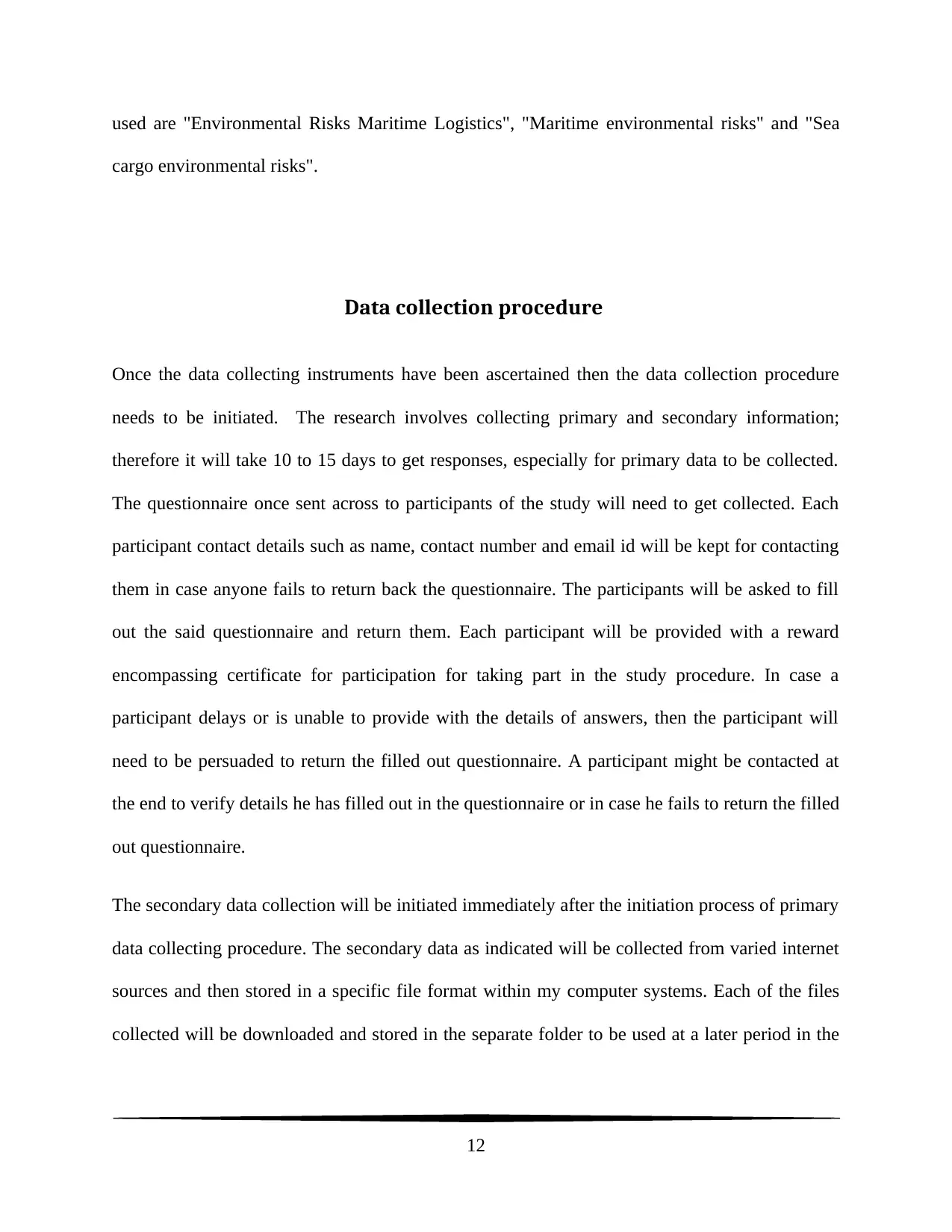
used are "Environmental Risks Maritime Logistics", "Maritime environmental risks" and "Sea
cargo environmental risks".
Data collection procedure
Once the data collecting instruments have been ascertained then the data collection procedure
needs to be initiated. The research involves collecting primary and secondary information;
therefore it will take 10 to 15 days to get responses, especially for primary data to be collected.
The questionnaire once sent across to participants of the study will need to get collected. Each
participant contact details such as name, contact number and email id will be kept for contacting
them in case anyone fails to return back the questionnaire. The participants will be asked to fill
out the said questionnaire and return them. Each participant will be provided with a reward
encompassing certificate for participation for taking part in the study procedure. In case a
participant delays or is unable to provide with the details of answers, then the participant will
need to be persuaded to return the filled out questionnaire. A participant might be contacted at
the end to verify details he has filled out in the questionnaire or in case he fails to return the filled
out questionnaire.
The secondary data collection will be initiated immediately after the initiation process of primary
data collecting procedure. The secondary data as indicated will be collected from varied internet
sources and then stored in a specific file format within my computer systems. Each of the files
collected will be downloaded and stored in the separate folder to be used at a later period in the
12
cargo environmental risks".
Data collection procedure
Once the data collecting instruments have been ascertained then the data collection procedure
needs to be initiated. The research involves collecting primary and secondary information;
therefore it will take 10 to 15 days to get responses, especially for primary data to be collected.
The questionnaire once sent across to participants of the study will need to get collected. Each
participant contact details such as name, contact number and email id will be kept for contacting
them in case anyone fails to return back the questionnaire. The participants will be asked to fill
out the said questionnaire and return them. Each participant will be provided with a reward
encompassing certificate for participation for taking part in the study procedure. In case a
participant delays or is unable to provide with the details of answers, then the participant will
need to be persuaded to return the filled out questionnaire. A participant might be contacted at
the end to verify details he has filled out in the questionnaire or in case he fails to return the filled
out questionnaire.
The secondary data collection will be initiated immediately after the initiation process of primary
data collecting procedure. The secondary data as indicated will be collected from varied internet
sources and then stored in a specific file format within my computer systems. Each of the files
collected will be downloaded and stored in the separate folder to be used at a later period in the
12
⊘ This is a preview!⊘
Do you want full access?
Subscribe today to unlock all pages.

Trusted by 1+ million students worldwide
1 out of 28
Related Documents
Your All-in-One AI-Powered Toolkit for Academic Success.
+13062052269
info@desklib.com
Available 24*7 on WhatsApp / Email
![[object Object]](/_next/static/media/star-bottom.7253800d.svg)
Unlock your academic potential
Copyright © 2020–2025 A2Z Services. All Rights Reserved. Developed and managed by ZUCOL.





